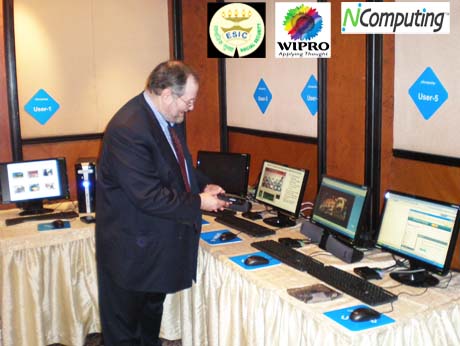
Wipro solution will deploy NComputing’s virtual PC technology across 31,000 nodes, 1500 hospitals, of Employees State Insurance Corp.
From Anand Parthasarathy/ Bangalore Nov 10 2009: Cloud Computing – relying on the Internet to satisfy one’s computing needs -- may see its biggest application in India, roll out over the next few months, and the result will be a protective cloud of social security for 12 million citizens who are members of the state-run Employees State Insurance Corporation.
On Tuesday, details became available of the Rs 1182 crores ( Approx $ 240 million) contract that ESIC has placed on Wipro Ltd to create one of the largest medical records data bases in the world for ESIC’s members; automating the operations of 140 plus hospitals, 1388 dispensaries and 620 branch insurance offices across India over the next 15 months. Wipro will use open source software to keep software costs down in the ESIC project; however the NComputing solution works as well with Windows.
Wipro has selected the US –based desktop virtualization leader, NComputing as its technology partner and will deploy 31,000 of the latter’s L 130 ‘thin clients’ as well as NComputing’s vSpace virtualization software to create a green and power efficient computing backbone.
NComputing’s flagship product is its virtual desktop solution where one standard PC can be used to fuel anywhere between 10 and 30 workstations – each with a monitor, mouse and keyboard -- through a small palm sized access terminal. This reduces the hardware costs by about 75 percent and cuts power consumed by an individual station to a tenth of what a PC would consume.
In a media briefing shortly before the Wipro-ESIC engagement was announced, NComputing CEO Stepher Dukker, said the company’s virtual desktop was the world’s cheapest computing solution and was currently being deployed across 2 million nodes serving 50,000 customers in 140 countries. While the US accounted for 40 percent of N Computing installations, India was its next largest market – and poised to be become no. 1 in two years. This confident prediction seems entirely plausible, given the rapid growth of NComputing’s India-based business since it set up base here two years ago. Last year, the company partnered with NComputing to fuel a $ 2 million 5000-school, 50,000- desktop deployment across the government school system in Andhra Pradesh. Last week, the company completed the installation of 10,000 desktops across 1000 adult learning centres of the Maharashtra Knowledge Corporation Ltd (MKCL).
Raj Shah, NComputing’s Chief Marketing Officer said the virtual desktop terminals typically cost less than Rs 5000 each and are available as Ethernet or PCI Express compatible wired devices. In the demo set up during the Bangalore launch, 6 Monitors were running CPU-intense graphics and video software from a single standard PC.
Tuesday also saw the launch in India of the industry’s first USB- thin client device: the U 170 virtual desktop kit weighs 100 grams and can be installed with monitor and keyboard in less than five minutes. The company planned to progressively shift the hardware assembly to India as demand here grows, he added.
Tech note: ( from NComputing resources: www.ncomputing.com ):
NComputing virtual desktops share the excess power of standard PCs and make computing simple and affordable. You save money by sharing the cost of a single PC among multiple users. And your users feel like they each have their own PC while they simultaneously share common applications—including web browsers, e-mail, office suites, and multimedia. Every user has their own keyboard, screen, settings, applications, and data files, so their experience is just like it would be if they were working at an independent PC.
Features:
vSpace software creates virtual desktops
vSpace creates an independent workspace for each user on the shared computer. Each workspace is a virtual desktop that looks and feels just like it would on a standalone PC. Users interact with their virtual desktop through their L-series access device. And the access device communicates to vSpace via the highly efficient User eXtension Protocol (UXP)
Link to L170 story at Virtualization Journal http://virtualization.sys-con.com/node/1149338